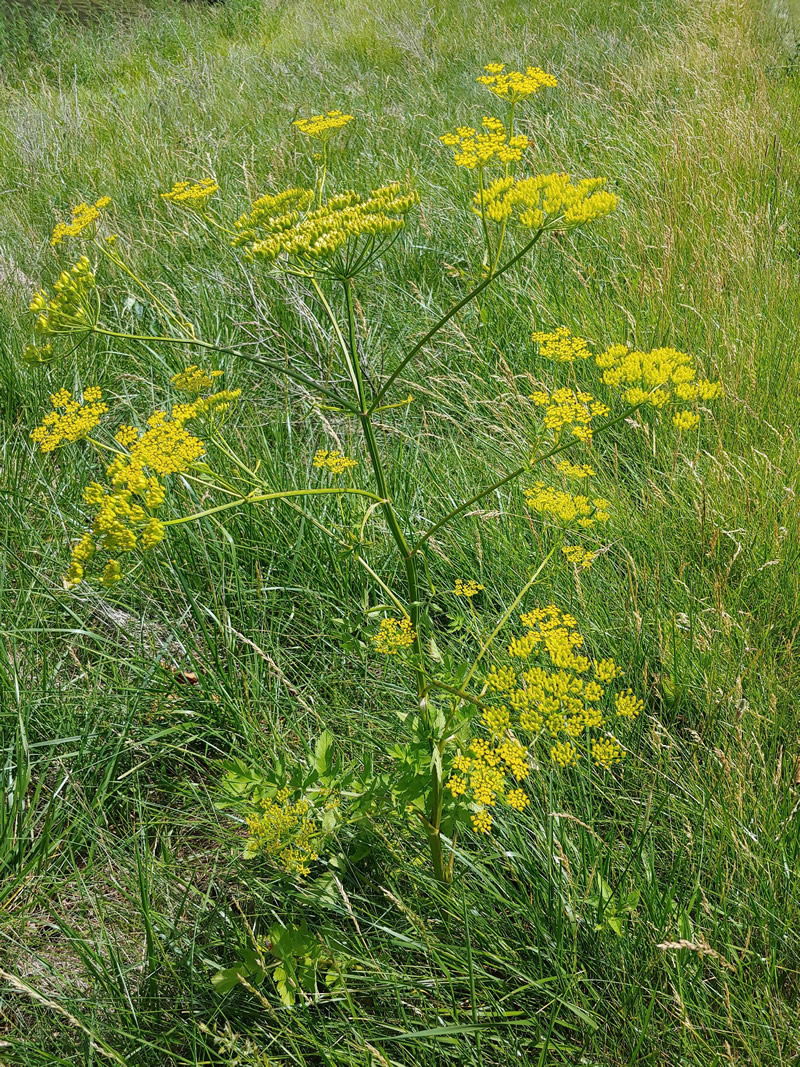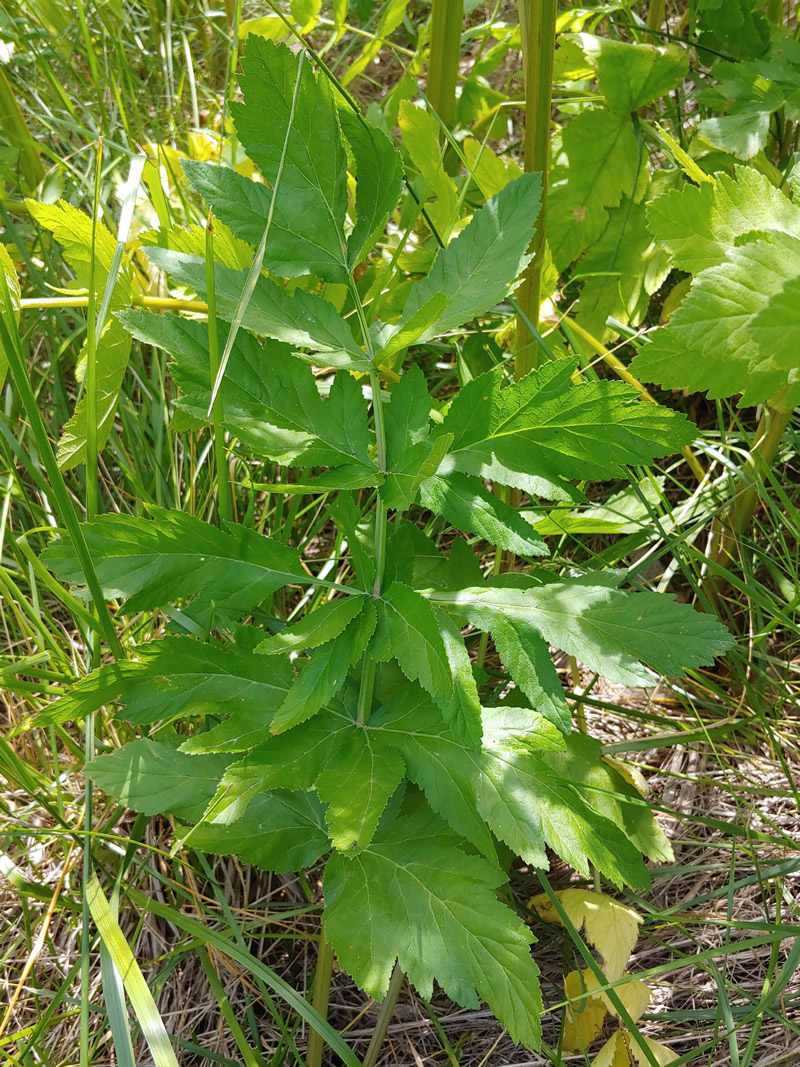Issue 5, June 18, 2019
Wild Parsnip
Wild Parsnip – A Weed to Know and Avoid
Wild parsnip (Pastinaca sativa) has been in the news recently, but many still do not know about this plant and the harm it can cause. It seems to be quite common now in central Illinois, so many have likely seen this plant before. Familiarity can breed complacency, unfortunately. The roadsides along I-72 between Springfield and Champaign were a full of it last week during a drive. Yet, ironically, that same day a reporter in Chicago was trying to contact me about the recent discovery of this weed there where it is much less common than in rural areas. The Chicago Tribune had run a story on it the day before. A few days before that, I identified a plant as being wild parsnip for the University of Illinois Plant Clinic. Who knew that the same inquiry would send the media’s gears into motion? And mine as well as the case may be…

Wild parsnip in bloom
Wild parsnip is somewhat of a pretty plant with an attractive flower. Any unsuspecting person who cuts that flower for a bouquet or cuts back the tall stems could learn quickly one reason why this plant is concerning. Another name for this plant is poison parsnip, but it is not really poisonous so to speak. It has the ability to cause sun-induced blistering or “burns” on the skin. The sap contains chemicals (furocoumarins) that cause phytophotodermatitis. Basically, if your skin absorbs these chemicals and is then exposed to sunlight, an interaction takes place; the result is reddened burned-like skin and/or blisters.
Another reason this plant is concerning is its ability to spread rapidly. It is listed as an “invasive species of major concern” in the book “Invasive Plants of the Upper Midwest.” Illinois residents have witnessed populations explode over the last decade or so. Early detection and eradication is essential to prevent future spread and combat current infestations.
We’ve also seen teasel spread rapidly in recent years. Like teasel, wild parsnip is a monocarpic perennial. That means this plant will not die until it has flowered and produced seed. Seeds are then viable in as little as 3 weeks after flowering. Data has shown seed to be mature by mid-July for northern and central Illinois. Seed dispersal typically occurs in the fall. The plant then dies, but seeds can remain viable in the soil for 4 years.
Plants begin as a rosette of leaves and remain as such for at least one year. Rosette leaves are upright and average 6 inches in height. Mature plants can reach 4 feet or more in height and have leaves that are pinnately compound, alternate on the stem, divided once into 5 to 15 leaflets with coarsely sawtoothed edges, and hairless. Leaflets are found in pairs. Flower heads are yellow, 2 to 6 inch wide umbels and are found at the tops of stems and branches. Often lateral blooms reach taller than the central blooms do. Individual flowers have 5 petals and are quite small with hundreds per plant. Blooms typically first appear in early June, but can occur through late summer. Wild parsnip can be found in a wide range of growing conditions but it does not tolerate shade. A close relative, poison hemlock, can often be found growing alongside wild parsnip. Although similar in stature, it has white, umbrella-shaped blooms.

Wild parsnip leaves
Wild parsnip can be easily confused with two yellow blooming, native prairie species: prairie parsley and golden Alexander. Compared to wild parsnip, prairie parsley has smaller, more rounded flowers and golden Alexander stems are shorter with umbels (flowers) that are less open.
Recently, I wrote about increased Butterweed (cressleaf groundsel) populations causing fields to be strikingly yellow. By now, many of those fields have been planted or at least sprayed, and with time, butterweed blooms have faded. Another yellow weed in bloom right now along roadsides that is a common occurrence in the state is yellow sweet clover, but the flowers look completely different than that of wild parsnip. Flowers are “pealike” in clustered spikes in the top 4 inches of elongated stems.
Clearly, wild parsnip can be misidentified or confused with several other plants. Uninformed landscape and roadside managers are certainly at risk of being injured by the sap. Proper identification and then covering the skin when working with this plant is essential. Learn this plant. Educate your employees, neighbors, family, and friends. Most are familiar with “leaves of three, leave it be” when it comes to poison ivy. There aren’t any cute rhymes for wild parsnip but it should be treated similarly. Always handle unfamiliar plants with caution. A good weed ID book can be beneficial.
While hand pulling or working around plants that cause skin conditions, wear long pants, long sleeves, shoes with socks, and waterproof or heavy gloves. Working after sunset can help prevent blistering and burns too. While mowing can reduce seed production of wild parsnip, string trimmers are not recommended as small pieces can be thrown towards unprotected skin easily. Mowing should be used after peak flowering but before seeds have set. Otherwise, seeds will be distributed by the mower. Resprouting can occur after mowing, and repeated mowing may be necessary to prevent flowering. The cut flowering stems of many weeds such as teasel are capable of continuing to develop seeds before they eventually die. I trust that wild parsnip would be no different. Mowers that chop stems more thoroughly than say a sickle bar mower could be more effective with control, however, more cut pieces means more risk of exposure to the sap. Managers should protect themselves accordingly.
In moist conditions, plants may be easily hand-pulled. Before flowering, rosettes can be killed using a sharp shovel to cut through the root, 1-2 inches below the ground. Removing and gathering or bagging up seed heads from the site prior to dispersal can work to greatly decrease populations over time.
Applying a herbicide to the rosette in the early fall or late spring (before flowering) can be effective. Repeat applications may be necessary. Suggested options include 2,4-D, dicamba, triclopyr, or metsulfuron. Spot treatments of glyphosate can be effective as well. As always, carefully read and follow all label directions.
For more in-depth information on controlling wild parsnip, check out this blog post from our colleagues at the University of Wisconsin-Madison:
https://ipcm.wisc.edu/blog/2016/07/wild-parsnip-an-expanding-problem-along-roadsides-in-wisconsin/
References:
Invasive Plants of the Upper Midwest by Elizabeth Czarapata
Management of Invasive Plants and Pests of Illinois by Tricia Bethke, Chris Evans, and Karla Gage
Author:
Michelle Wiesbrook